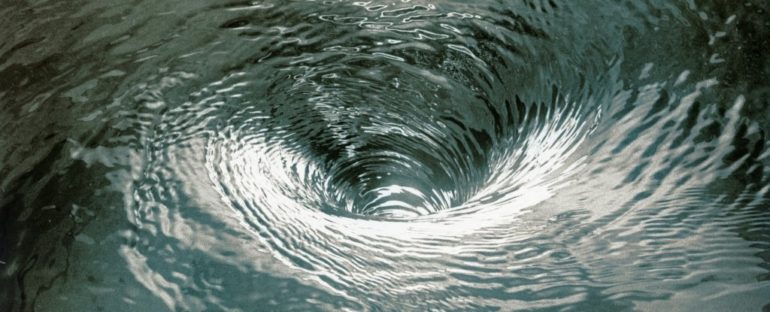When a black hole is active, we tend to focus on the effect it has on the material it’s slurping up. It makes sense to do so; black holes themselves are difficult to probe. But the interaction between the black hole and the material should have an effect on the black hole, too – as it gains material, it should also gain in mass.
Such small feedback responses – especially ones previously ignored as trivial – are known as backreactions, and scientists have just observed an analogue of one that’s specific to black holes, and which can be seen in water swirling down a drain.
It’s a detection that could help study black hole phenomena that are too subtle for our current instruments, such as the Hawking radiation that is thought to be emitted by black holes. This is a theoretical type of black-body radiation that would eventually – after a very, very long time – see a black hole completely evaporate, provided it was not growing at all.
In order to study cosmic objects in finer detail than we can across the vast distances of space, scaled-down versions, or analogues, can be created in a lab. Like, for instance, a recent experiment to replicate white dwarf core pressures.
Black hole analogues are an excellent way to find out more about these enigmatic objects, and different kinds can help reveal their secrets in multiple ways.
Optical fibre and Bose-Einstein condensates have both been used to learn more about Hawking radiation. But one of the simplest has to do with how black holes feed: the draining bathtub vortex.
Black hole accretion can be compared with water swirling down a drain. Treating matter as a ripple in a field, the water can stand in for spacetime itself, or a field rippling with quantum activity.
Measuring the ripples responses as the water vanishes down a swirling drain might have something to say about waves of energy disappearing into a black hole.
A bathtub vortex black hole analogue. (The University of Nottingham)
From such analogues, we’ve learnt a lot about the effect of black holes on the space and material around them. But with an external water pump keeping the background of the system steady, it was unclear whether a water black hole analogue would have the freedom to be able to react to waves.
This set of experiments is the first time a draining bathtub vortex has demonstrated an effect on the black hole itself.
“We have demonstrated that analogue black holes, like their gravitational counterparts, are intrinsically backreacting systems,” said physicist Sam Patrick of the University of Nottingham in the UK.
“We showed that waves moving in a draining bathtub push water down the plug hole, modifying significantly the drain speed and consequently changing the effective gravitational pull of the analogue black hole.”
When waves were sent rippling into the system towards the drain, they pushed extra water in, accelerating the “accretion” process so significantly that the water levels in the tub dropped noticeably, even while a pump maintained the same level of water going in.
This change in the water level corresponds to a change in the properties of the black hole, the researchers said.
This could be extremely useful information, partially because an increase in mass changes the gravitational strength of a black hole – it changes the way the black hole warps its surrounding spacetime, as well as the effect the black hole has on the accretion disc. In addition, it offers a new way to study how waves can affect black hole dynamics.
“What was really striking for us is that the backreaction is large enough that it causes the water height across the entire system to drop so much that you can see it by eye! This was really unexpected,” Patrick said.
“Our study paves the way to experimentally probing interactions between waves and the spacetimes they move through. For example, this type of interaction will be crucial for investigating black hole evaporation in the laboratory.”
The team’s research has been published in Physical Review Letters.



